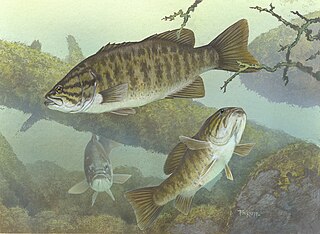
Micropterus is a genus of North American freshwater fish collectively known as the black bass, which belong to the sunfish family Centrarchidae of order Perciformes. They are sometimes erroneously called "black trout", but the name trout more correctly refers to certain potamodromous members of the family Salmonidae.

The Squaliformes are an order of sharks that includes about 126 species in seven families.

Gambusia is a large genus of viviparous fish in the family Poeciliidae. Gambusia contains over 40 species, most of which are principally found in freshwater habitats, though some species may also be found in brackish or saltwater habitats. The genus Gambusia comes from the Cuban term, "Gambusino", which means "free-lance miner". The type species is the Cuban gambusia, G. punctata. The greatest species richness is in Mexico, Texas, and the Greater Antilles, but species are also found elsewhere in the eastern and southern United States, the Bahamas, Central America, and Colombia. Gambusia species are often called topminnows, or simply gambusias; they are also known as mosquitofish, which, however, refers more specifically to two species, G. affinis and G. holbrooki, which are often introduced into ponds to eat mosquito larvae. As a consequence, they have been introduced widely outside their native range, and frequently become invasive, threatening local species. G. affinis and G. holbrooki are now established in many parts of the world and are likely to continue to spread as climatic conditions change. They are only occasionally kept in aquariums, due to their relative lack of color and the highly aggressive nature of the aforementioned mosquitofish species.

The Gonostomatidae are a family of mesopelagic marine fish, commonly named bristlemouths, lightfishes, or anglemouths. It is a relatively small family, containing only eight known genera and 32 species. However, bristlemouths make up for their lack of diversity with relative abundance, numbering in the hundreds of trillions to quadrillions. The genus Cyclothone is thought to be one of the most abundant vertebrate genera in the world.

Members of the genus Lophius, also sometimes called monkfish, fishing-frogs, frog-fish, and sea-devils, are various species of lophiid anglerfishes found in the Atlantic and Indian Oceans. Lophius is known as the "monk" or "monkfish" to the North Sea and North Atlantic fishermen, a name which also belongs to Squatina squatina, the angelshark, a type of shark. The North European species is Lophius piscatorius, and the Mediterranean species is Lophius budegassa.

Rasbora is a genus of fish in the family Cyprinidae. They are native to freshwater habitats in South and Southeast Asia, as well as southeast China. A single species, R. gerlachi, is only known from an old specimen that reputedly originated from Africa (Cameroon), but this locality is considered doubtful. They are small, up to 17 cm (6.7 in) long, although most species do not surpass 10 cm (4 in) and many have a dark horizontal stripe.

Notothenioidei is one of 19 suborders of the order Perciformes. The group is found mainly in Antarctic and Subantarctic waters, with some species ranging north to southern Australia and southern South America. Notothenioids constitute approximately 90% of the fish biomass in the continental shelf waters surrounding Antarctica.

The New Zealand sand diver is a species of sandburrower endemic to the waters around New Zealand where it can be found in tide pools and areas with sandy substrates down to a depth of 5 metres (16 ft). This species can grow to a length of 7 centimetres (2.8 in) TL. This species is the only known member of its genus.
The sandburrowers or simply burrowers are a family, Creediidae, of ray-finned fishes in the order Acropomatiformes.

Leiarius is a genus of long-whiskered catfishes native to South America. Most of the genus' species are found in the aquarium hobby as ornamental fish.

An anchovy is a small, common forage fish of the family Engraulidae. Most species are found in marine waters, but several will enter brackish water, and some in South America are restricted to fresh water.
Apodocreedia vanderhorsti, the longfin burrower, is a species of sandburrower native to the Indian Ocean coast of southern Africa where it can be found from Delagoa Bay, Mozambique to Durban, South Africa. It occurs from the intertidal zone to a depth of approximately 16 metres (52 ft). This species grows to a length of 8 centimetres (3.1 in) TL. This species is the only known member of the genus Apodocreedia.
Creedia is a genus of sandburrowers native to the Indian and western Pacific oceans.
Crystallodytes is a genus of sandburrowers native to the Pacific Ocean.

Limnichthys is a genus of sandburrowers native to the Indian and Pacific oceans.
Myopsaron nelsoni, is a species of sandburrower only known from around the Ogasawara Islands, Japan, where it has been collected at depths of from 51 to 99 metres over flat, sandy bottoms. This species grows to a length of 3.6 centimetres (1.4 in) SL. This species is the only known member of its genus.
Schizochirus insolens, the brokenfin sandburrower, is a species of sandburrower native to the coastal waters and bays of eastern Australia from Rockhampton, Queensland to Sydney. This species grows to a length of 5.3 centimetres (2.1 in) SL. This species is the only known member of its genus.
Creedia alleni is a species of sandburrowers found in the Eastern Indian Ocean in Australia. This species reaches a length of 4 cm (1.6 in).
Creedia bilineata is a species of sandburrowers found in the Northwest Pacific Ocean around Japan. This species reaches a length of 3.2 cm (1.3 in).
Creedia haswelli, the slender sandburrower, is a species of marine ray-finned fish belonging to the family Creediidae, the sandburrowers. This species is found in Southern Australia. This species reaches a length of 7.5 cm (3.0 in).










